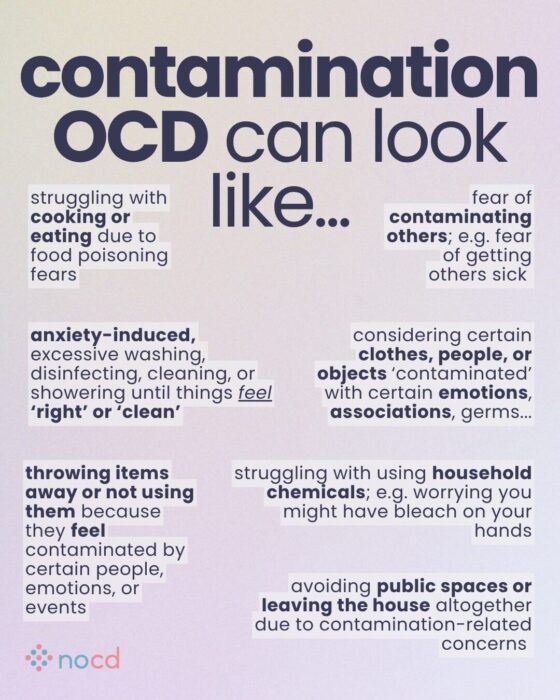It’s normal to worry about getting sick sometimes, but if you constantly find yourself concerned that touching certain objects or people will contaminate you, or worry that you’ll accidentally infect others, you might be dealing with contamination OCD.
Contamination OCD isn’t just about being cautious about illness and germs—it’s a mental health condition that is usually overwhelming. Luckily, it’s also highly treatable. Let’s break down what contamination OCD is, common signs to look out for, and how to best manage your symptoms.
What is contamination OCD?
Contamination OCD is a subtype of obsessive-compulsive disorder (OCD) that involves intrusive thoughts about being contaminated, contaminating others, or feeling disgusted by contaminants. Like all forms of OCD, it follows the same cycle: obsessions—unwanted thoughts, feelings, urges, images, and sensations that cause distress—trigger compulsions, which are behaviors or mental actions done to relieve that distress.
With contamination OCD, obsessions and compulsions revolve around feeling dirty (both physically and emotionally). Some of the most common fears associated with this subtype include a fear of germs, dirt, or a lack of cleanliness. “As you can imagine, this can take up quite a large chunk of your mental energy,” says Catherine Schuler, Psy.D.
It is important to note that not all contamination OCD fears are the same. Some people experience a strong fear of illness, leading to intrusive thoughts like, “What if I get seriously sick from touching this?” Others experience a pervasive sense of disgust that isn’t always associated with getting sick, or getting others sick. In this situation, you may think: “I’ll never feel clean enough, no matter how much I wash.”
Contamination OCD can also lead to concerns about mental or emotional “contamination,” even when there is no physical contact. Let’s dive deeper into some of the different ways this subtype of OCD can manifest:
Physical contamination
Physical contamination involves worrying about coming into contact with something—or someone—you believe could contaminate you. This might mean avoiding public restrooms, refusing to shake hands, or excessively washing your hands and clothes to feel “safe.”
Mental contamination
Mental contamination isn’t about physical contact. Instead, it’s the unsettling feeling of being “dirty” internally, even when there’s no obvious source of contamination. This can be triggered by certain thoughts, memories, or feelings that trigger compulsions meant to “cleanse” the mind, or avoid things that make you feel dirty.
Emotional contamination
Emotional contamination OCD involves the fear that a person, object, or place carries negative energy or traits that could somehow transfer onto you. This might look like avoiding spaces associated with certain people, throwing away objects tied to bad memories, or feeling an overwhelming need to mentally “purify” yourself after an interaction.
Contamination OCD symptoms
Contamination OCD is made up of two core symptoms: obsessions and compulsions. If you find yourself stuck in cycles of fear and ritualistic behaviors related to cleanliness, you could dealing with contamination OCD. Let’s explore some of the more common symptoms of this subtype.
Common obsessions in contamination OCD
- What if I get cancer?
- What if I magically get a disease just by talking about it?
- What if I spread an illness to someone else and they die?
- What if I inadvertently spark the next global pandemic?
- What if I hug someone with a noncontagious condition, and it somehow transfers to me?
- Could this food be contaminated?
- Someone just coughed near me; what if I get sick and die?
- My partner and I have tested negative for sexually transmitted infections, but what if I still get one and it’s incurable?
- I feel dirty and disgusting, even though I’ve already showered.
- If I touch that doorknob, I’ll never feel clean again.
- If I make eye contact with that person or sit where they were, I might absorb some of their negative traits.
Many people worry about germs or illness from time to time, but OCD makes these thoughts feel difficult to shake. “Contamination OCD can feel like the world is attacking you,” says April Kilduff, MA, LCPC, LPCC, LPC, LMHC.
Common compulsions in contamination OCD
- Excessive hand washing, showering, and cleaning.
- Separating “contaminated” items from “non-contaminated” items.
- Throwing away items perceived as contaminated.
- Changing clothes repeatedly.
- Using harsh cleaners on the skin.
- Spending excessive time researching germs, illnesses, and diseases.
- Over-sanitizing objects, even when unnecessary.
- Tracking items that have been touched to either avoid or clean them.
- Restricting food choices due to irrational fears of contamination.
- Overusing gloves or hand sanitizer.
- Repeatedly asking for reassurance that you’re not contaminated or won’t make others sick.
- Engaging in rituals like excessive praying, knocking, or repeating words, to try to mentally “undo” contamination.
- Avoiding public bathrooms.
- Steering clear of cemeteries due to fears of being “contaminated” with death germs.
While these compulsions might feel like the only way to ease anxiety, they actually fuel the OCD cycle. The more you engage in them, the more your brain learns to rely on them, reinforcing your fears.
How contamination OCD can affect you
When contamination OCD isn’t treated properly, it can start to seep into every part of your daily life. What might begin as a fear of germs or a need to feel clean can spiral into hours of compulsions. Work, relationships, and everyday routines can suffer when so much time and energy is spent avoiding contamination or trying to “undo” it.
OCD also has a way of targeting what matters most to you. “It’s not surprising that contamination OCD is so common,” says Schuler. “Good health is important to most people.” Unfortunately, the compulsions you may take to try to protect your well-being often end up harming it, by isolating you socially and taking up time you could be spending on healthy habits, like mindfulness or exercise.
Contamination related compulsions can also impact your physical health. “We’ve seen people wash and sanitize so much that their skin becomes dry, cracked, and even starts to bleed—ironically making them more vulnerable to contamination,” says Kilduff. She adds that some people go as far as washing themselves with bleach, while others lose an unhealthy amount of weight because their fear of contaminated food keeps them from eating.
No matter how suffocating contamination OCD might feel, remember that OCD is highly treatable. With the right approach, you can learn to manage symptoms in a way that allows you to reclaim your time and energy.
Find the right OCD therapist for you
All our therapists are licensed and trained in exposure and response prevention therapy (ERP), the gold standard treatment for OCD.
Treatment for contamination OCD
The most effective treatment for any subtype of OCD is exposure and response prevention (ERP) therapy, a specialized form of cognitive behavioral therapy (CBT) that helps you confront your fears and learn to tolerate uncertainty without relying on compulsions.
ERP works by gradually exposing you to situations that will trigger your fears around contamination, while helping you resist compulsions. Instead of avoiding certain objects, spaces, or activities—or performing rituals to “neutralize” distress—you’ll learn to sit with discomfort and allow anxiety to pass on its own.
ERP isn’t about forcing yourself into distressing situations for the sake of suffering—it’s about teaching your brain that the fears OCD creates aren’t real threats. It’s a gradual process. “No one expects you to dive into your worst fear right away,” says Kilduff. With practice, you’ll begin to see that the distress fades naturally—without needing to wash, sanitize, or seek reassurance.
Ashley Marie Berry is a NOCD therapy member who has experienced the benefits of ERP therapy for contamination OCD firsthand. While ERP wasn’t always easy, Berry believes it helped change her life. “My confidence grew every time I felt my anxiety drop. Thoughts that once took over my life were now drifting behind me,” she says.
Because OCD is a complex condition, it’s important to work with a therapist who specializes in treating it—specifically with ERP. A trained OCD specialist will know how to guide you through exposures in a way that’s effective and tailored to your specific fears, helping you build the skills needed for long-term recovery.
Bottom line
Contamination OCD can be exhausting, making even simple tasks feel complicated. But like all forms of OCD, it is important to remember that it is treatable. Fears that feel urgent now don’t have to control your life forever. With ERP therapy, you can learn to navigate the uncertainties of life without relying on compulsions, and start focusing on the things that truly matter to you.


